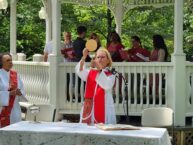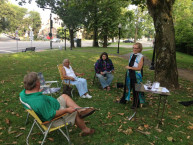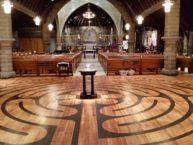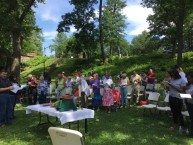May God’s words alone be spoken, may God’s words alone be heard. Amen.
[singing] “Two turtledoves, and a partridge in a pear tree.” Now you all thought we were done with Christmas. Well, the holiday yes, but the birth narrative, not so much. But before we get to that, I want to share with you something a priest friend of mine posted a few weeks ago on Facebook. It seems she was wanting to hold an evensong for Candlemas, and for some reason, no one in the choir was able to be there. They all had something to do that night…hmmm….Today is candlemas – what on earth could everyone be doing tonight…chasing down Puxatawny Phil? Oh wait, that’s right, it’s Super Bowl Sunday! Well, let’s just say that she abandoned all hope for holding an evensong on Feb. 2nd of this year. And on that note…Go Peyton Manning!
Now, where were we… oh yes, Jesus is still a wee little baby, and Mary and Joseph have brought him to the temple to be circumcised and named, and for Mary to participate in the purification. They brought with them two turtle doves…and that little part of the narrative speaks volumes. And the holy family is greeted by Simeon and the prophet Anna – who recognize the redemption of the world in this little baby. And Simeon exclaims his joy in the words we have come to know as the Nunc Dimittis, a favorite compline canticle. As it reads in the Book of Common Prayer:
Lord, you now have set your servant free *
to go in peace as you have promised;
For these eyes of mine have seen the Savior, *
whom you have prepared for all the world to see:
A Light to enlighten the nations, *
and the glory of your people Israel.
This is one of the many revealings in the season of Epiphany. We are told, as Mary and Joseph are, who Jesus is, and what that means for us.
This is the feast of the Presentation. It is also Candlemas.
“Taking a cue from Simeon, some churches began, in time, to mark this day with a celebration of light: the Candle Mass, during which priests would bless the candles to be used in the year to come. Coinciding with the turn toward spring and lengthening of light in the Northern Hemisphere (providing a certain ground hog today didn’t see his shadow), Candlemas offers a liturgical celebration of the renewing of light and life that comes to us in nature at this time of year, as well as in the story of Jesus. As we emerge from the deep of winter, the feast reminds us of the perpetual presence of Christ our Light in every season.”
But there will be a lot of light this evening…and no, not just Bud Lite. There will be the lights of the stadium, the glittering sparks of cameras flashing, and the lights on the media trucks stationed all over the meadowlands for the big game. The Super Bowl is more than a football game – it is THE football game. It is an extraordinary experience of a rather ordinary pastime. In some ways, it fits very nicely with our gospel today – as there are lessons for us all in both.
This Gospel was written at a time when telling a story about going to the temple to participate in required rituals was something that happened in “the good old days.” The temple had been destroyed, for the second time, around 70CE, and this gospel, by accounts of most critical scholarship, was written a decade or more later. So, “on the one hand, readers can see the setting as hearkening back to remembrance of a time when life seemed safe, traditions were observed… on the other hand, it may be a poignant reminder of the catastrophe that already exists in the memory of Luke’s readers: the Temple’s destruction. As one commentator noted, “This juxtaposition of memories presents a yellow caution light−a warning against painting too thick a veneer of harmony and tranquility over the past. Underneath that veneer, cracks will appear in the surface, evidence of the tensions percolating underneath.”1
And tensions we do have, then and today.
The tension between the past and the future, between darkness and light, between what seems to be and what is, between the ordinary and the extraordinary. It is all a part of life, a part of being in this world. How we live into those tensions – now that is something to consider.
The presentation at the temple was a thing of the past. But the Jewish people adapted to changing circumstances, and even today, newborns are named and celebrated by the parents, a Rabbi, family and friends at the Brit Milah or Bris. Tradition is transformed, and in its transformation, it is given new life.
Jesus is only forty days old, and the old people, Simeon and Anna, are living into tensions as well – of darkness and light. Simeon and Anna were mystics – and of the two, only Anna was identified as a prophet. They saw what others were not seeing, not even Joseph and Mary. They saw a light, but one that must first come through the darkness of opposition, and through Mary’s pierced heart.”
The prophet Anna and the mystic Simeon knew that Jesus was the light that would break through the darkness of their time, and deliver those who were hungry and thirsty physically and spiritually.
Darkness always exists – it existed then – it exists now.
And tonight, we will experience light cutting through darkness in Metlife Stadium to bring us the Super Bowl. But the darkness that exists beyond the walls of the stadium is something no floodlight can illuminate. At the Superbowl – all those lights/glitz/media…they can blind us to the darkness of what accompanies this event – human trafficking, domestic violence, and child abuse.
The Super Bowl is considered the largest event for the bartering of human beings – women, children, and men – for sex in the world. The Super Bowl is also a time when people gamble, drink, and take out their losses on their families. It is one of the biggest days for reports of child abuse to DYFS every year. And of course, there will be the drunk driving accidents following the game.
But even in the face of this horrific dark side of our inhumanity, in this rather ordinary act we hear about in the gospel today, we are given extraordinary hope. Now, I want to get back to that part about the two turtle doves, because that is important. See, the proscribed offering was a lamb and a turtle dove. But if one was poor, two turtle doves would be used – which is what Mary and Joseph brought that day. We observe from their offering, the lowliness of Jesus family and their marginalized position in society. Indeed, hope seems most evident in places of extreme poverty when those with the least seem to continue to embrace the rituals of an abundant life. Jesus was from poverty and as we hear later in Luke was to bring salvation to the poor.
Today, it is those living in poverty who are sold into slavery for sex. It is the poor in spirit and in circumstance who gamble to get a leg up (or from addiction). It is the victims of violence who seek safe haven from their personal storms – and sometimes that is living on the streets. It is for these that Jesus came most of all.
“On this day we commemorate Jesus being presented in the temple. But every day people are presented to us, strangers out of darkness. And we are called to be as Anna and Simeon, and see the light in them and each other. Because of the darkness that shadows so many of us, we are [sometimes] afraid to look. But, we can be brave.”2 We can take heart from the ordinary. The ordinary that leads to the extraordinary. Because our ordinary lives have been blessed by the extraordinary experience of Christ.
We see this in Simeon and Anna, who witness an ordinary peasant couple observing the ordinary rituals expected of Jewish parents – and they see with spiritual eyes the “consolation of Israel.” Even Mary and Joseph are amazed at their words. The ordinary becomes the extraordinary. Mary and Joseph keep a religious ritual, and all who are there are transformed. How many of us look at church as something ordinary, as one more thing to squeeze into an already busy weekend? But what we find in this story is that when we come together to seek relationship with God, there is no such thing as ordinary! No matter where it happens, ritual in the name of God – be it baptism, Holy Eucharist, a bris, or prayer – the ordinary becomes the extraordinary – a transformational experience of the living community of faith!
And as we are transformed, so too are our communities. Because the light to “enlighten the nations,” the light to pierce the darkness, is present in us! We are the body of Christ alive in the world today, and we have work to do.
We need to have the faith that Anna and Simeon had – to recognize God’s presence in the ordinary of life.
When we need to see God’s redeeming work in the world around us, and have the faith to proclaim it.
We need to recognize God’s all inclusive love within ourselves, and respond not only with words, but with action.
And we need to live out this understanding of God’s love everywhere – in our hearts, in our church, and in our communities.
Church was never meant to be a place of the ordinary, because being a follower of Christ is always an extraordinary experience. We don’t gather together to celebrate only the Christ that was, but the Christ that is, and is to come! That is the mystery of our faith – that here, now, in this place, in this moment, in each of us, Christ is alive – born anew to bring a light to the world.
Born in each of us so that we may know the healing power of God’s love.
Brought to life in us in the Eucharist so that we might be given the strength to do the work we were called to do – to be the prophets of our day – the Anna’s of our time – to proclaim the good news.
The good news to those who walk in darkness – the darkness of hunger, oppression, slavery, and violence – that the light of Christ is alive in the world, and that we intend to spread the light so that all may know the healing power of God’s love.
These eyes of ours have seen the Savior!
The question is… what will you do with that?
Amen.
[Please note: All sermons are as written, not necessarily as delivered on that Sunday]
Rev. Diana Wilcox
Christ Episcopal Church of Bloomfield & Glen Ridge
February 2, 2014
Fourth Sunday After The Epiphany – Year A – The Presentation
First Reading – Malachi 3:1-4
Psalm 24:7-10
Second Reading – Hebrews 2:14-18
Gospel – Luke 2:22-40






